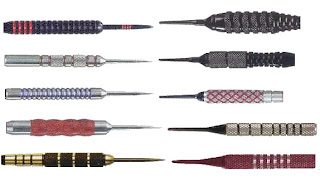Steel-tip darts can weigh up to 50 grams,
though you will have a very difficult time locating very many varieties above
30 grams. Most people throw darts that weigh between 20-25 grams.
Soft-tip darts are a different story, you
will need to check with your local leagues for the weight requirements. At the
time of this posting, 16 grams darts seem to be a safe bet no matter where you
are throwing. You can get a heavier soft-tip dart, but some leagues and
tournaments may ban them due to the construction or restraints of the machines
that are being used. An opponent can challenge the weight of your dart if they
feel it is too heavy.
If you're throwing soft-tip darts, go to
the 14-16 gram varieties to play it safe. If you're just starting in steel-tip
darts and do not have the ability to try out different weights to see what you
like, I would start off with a 21-22 gram dart.


